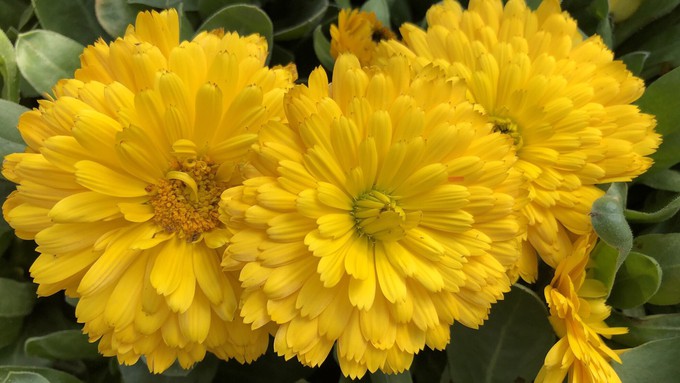
Frost reminds us: It’s still winter

Now there's some sunshine! Calendulas bring bright color to the winter garden. Kathy Morrison
After three weeks of rain, recent dry weather has been a window of opportunity to get things done outdoors. And there’s been a lot to do, including continued cleanup of fallen branches and downed trees.
Warmer weather prompted some plants to jump into spring mode. Daffodils have already started blooming. Roses are pushing out new growth.
But we have seven more weeks of winter – and a cold reminder in the coming nights.
Expect frost, says the National Weather Service. Overnight temperatures in Sacramento will dip down to 30 degrees on Monday and Tuesday nights, even lower in the foothills. Widespread frost is forecast for Wednesday morning, too. Make sure sensitive plants are protected; that includes new transplants.
Before the cold, we’ll see a storm blow through on its way to the Sierra. On Sunday, gusty winds will push through lots of clouds but the weather service expects little if any chance of rain in Sacramento. But those winds could bring down weakened branches and more tree debris.
Meanwhile, these final days of January will be colder than average – only 48 degrees Sunday before settling into the low 50s for most of the week. A slight chance of rain (25%) could arrive Thursday afternoon, but otherwise the forecast looks dry.
Bundle up and get work done!
* Prune, prune, prune. Now is the time to cut back most deciduous trees and shrubs. The exceptions are spring-flowering shrubs such as lilacs.
* Now is the time to prune fruit trees, except apricot and cherry trees. Clean up leaves and debris around the trees to prevent the spread of disease.
* Prune roses, even if they’re still trying to bloom or sprouting new growth. Strip off any remaining leaves, so the bush will be able to put out new growth in early spring.
* Prune Christmas camellias (Camellia sasanqua), the early-flowering varieties, after their bloom. They don’t need much, but selective pruning can promote bushiness, upright growth and more bloom next winter. Feed with an acid-type fertilizer. But don’t feed your Japonica camellias until after they finish blooming next month. Feeding while camellias are in bloom may cause them to drop unopened buds.
* Clean up leaves and debris around your newly pruned roses and shrubs. Put down fresh mulch or bark to keep roots cozy.
* Apply horticultural oil to fruit trees to control scale, mites and aphids. Oils need 24 hours of dry weather after application to be effective.
* This is also the time to spray a copper-based oil to peach and nectarine trees to fight leaf curl. Avoid spraying on windy days.
* Divide daylilies, Shasta daisies and other perennials.
* Cut back and divide chrysanthemums.
* Plant bare-root roses, trees and shrubs.
* Transplant pansies, violas, calendulas, English daisies, snapdragons and fairy primroses.
* In the vegetable garden, plant fava beans, head lettuce, mustard, onion sets, radicchio and radishes.
* Plant bare-root asparagus and root divisions of rhubarb.
* In the bulb department, plant callas, anemones, ranunculus and gladiolus for bloom from late spring into summer.
* Plant blooming azaleas, camellias and rhododendrons. If you’re shopping for these beautiful landscape plants, you can now find them in full flower at local nurseries.
Comments
0 comments have been posted.Sacramento Digs Gardening to your inbox.
Sites We Like
Garden Checklist for week of July 21
Your garden needs you!
* Keep your vegetable garden watered, mulched and weeded. Water before 8 a.m. to reduce the chance of fungal infection and to conserve moisture.
* Feed vegetable plants bone meal, rock phosphate or other fertilizers high in phosphate to stimulate more blooms and fruiting. (But wait until daily high temperatures drop out of the 100s.)
* Don’t let tomatoes wilt or dry out completely. Give tomatoes a deep watering two to three times a week.
* Harvest vegetables promptly to encourage plants to produce more. Squash especially tends to grow rapidly in hot weather. Keep an eye on zucchini.
* Pinch back chrysanthemums for bushy plants and more flowers in September.
* Remove spent flowers from roses, daylilies and other bloomers as they finish flowering.
* Pinch off blooms from basil so the plant will grow more leaves.
* Cut back lavender after flowering to promote a second bloom.
* It's not too late to add a splash of color. Plant petunias, snapdragons, zinnias and marigolds.
* From seed, plant corn, pumpkins, radishes, winter squash and sunflowers.